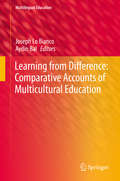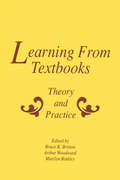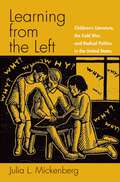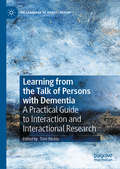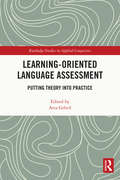- Table View
- List View
Learning English
Learning English focuses on young children's acquisition of spoken and written English in monolingual and bilingual contexts and explores the debates surrounding English in schools and colleges, and the often controversial nature of the English curriculum in different parts of the world. English is learned in most parts of the world, both through use in the home and community, and as a major language of education. Learning English represents just some of this diversity.
Learning from Communicators in Social Change: Rethinking the Power of Development (Communication, Culture and Change in Asia #7)
by Jan ServaesThis book presents the perspectives of some of the main players, both academics and professionals, in communication for sustainable development and social change so as to provide valuable lessons for future generations of change agents. It places emphasis on both the theoretical foundation and practical applications and ethical concerns in communication for development and social change. Most of the available historical accounts in development communications make a distinction between the modernization paradigm, the dependency paradigm and the multiplicity or participatory paradigm. These historical accounts have been dominated by framing developments within these paradigms, as the logical offspring of the Western drive to develop the world after colonization and the Second World War. The subsequent collapse of the Soviet Union in the late eighties, together with the rise of the U.S. as the only remaining ‘superpower,’ the emergence of the European Union and China, the gradual coming to the fore of regional powers, such as the BRICS countries, and the recent meltdown of the world financial system has rendered disastrous consequences for people everywhere. This book responds to these changes and challenges in presenting a rethinking of the “power” of development, and consequently the place and role of communication in it. It is aimed at both emerging research students, policymakers and social research practitioners who are interested in the history of communication for development and social change and the role and place of mayor players in it. This is most applicable to the political and educational sector, as well as scholars of history, social work, and human rights. The book will provide valuable insights for beginners in these fields who are not yet familiar with the increasingly important and emerging field of global social change.
Learning from Difference: Comparative Accounts Of Multicultural Education (Multilingual Education #16)
by Joseph Lo Bianco Aydin BalThis book analyses the experiences of multicultural education in nine very different international settings uncovering insights from a vast variety of educational contexts. Taking a multi-critical approach in reporting and discussing problems faced by increasingly multicultural and multilingual societies the nine case studies reflect radically different assumptions about what counts as ‘ difference’ and what should be the appropriate ways for education systems to respond to differences. While each country’s approach seems unique, analysis of the divergent treatments of internal population diversity elicits a genuinely global instance of the increasingly shared phenomenon of cultural pluralism. Discussing various successes and failures of policy enactment, theory, pedagogy and management of diversity, the book isolates both the differences and similarities in the unique geopolitical and socio-historical contexts of the countries investigated. A key value of the book is that it greatly expands the range of settings, experiences, epistemologies, ontologies and practical experiences that are typically encountered in mainstream discussion of what counts as 'multicultural education'. In effect, all societies are in some way ‘dealing with difference’ – this volume helps widen the scope of reflection and thus facilitates increased, global ‘learning from difference’.
Learning from Emergent Bilingual Latinx Learners in K-12: Critical Teacher Education (Routledge Research in Teacher Education)
by Pablo C. Ramirez Christian J. Faltis Ester J. De JongIn this volume, scholars, researchers, and teacher educators from across the United States present their latest findings regarding teacher education to develop meaningful learning experiences and meet the sociocultural, linguistic, and academic needs of Latino ELLs. The book documents how teacher education programs guide teachers to engage in culturally and linguistically diverse academic contexts and sheds light on the variety of research-based theoretical frameworks that inform teaching practices. A unique contribution to the field, Learning from Emergent Bilingual Latinx Learners in K-12 provides innovative approaches for linking Latino school communities with teachers at a time when demographic shifts are considerably altering population trends in the K-12 educational system.
Learning from Emergent Bilingual Latinx Learners in K-12: Critical Teacher Education (Routledge Research in Teacher Education)
by Pablo C. Ramirez Christian J. Faltis Ester J. De JongIn this volume, scholars, researchers, and teacher educators from across the United States present their latest findings regarding teacher education to develop meaningful learning experiences and meet the sociocultural, linguistic, and academic needs of Latino ELLs. The book documents how teacher education programs guide teachers to engage in culturally and linguistically diverse academic contexts and sheds light on the variety of research-based theoretical frameworks that inform teaching practices. A unique contribution to the field, Learning from Emergent Bilingual Latinx Learners in K-12 provides innovative approaches for linking Latino school communities with teachers at a time when demographic shifts are considerably altering population trends in the K-12 educational system.
Learning From Text Across Conceptual Domains
by Cynthia R. HyndThis volume is an attempt to synthesize the understandings we have about reading to learn. Although learning at all ages is discussed in this volume, the main focus is on middle and high school classrooms--critical spaces of learning and thinking. The amount of knowledge presented in written form is increasing, and the information we get from texts is often conflicting. We are in a knowledge explosion that leaves us reeling and may effectively disenfranchise those who are not keeping up. There has never been a more crucial time for students to understand, learn from, and think critically about the information in various forms of text. Thus, understanding what it means to learn is vital for all educators. Learning from text is a complex matter that includes student factors (social, ethnic, and cultural differences, as well as varying motivations, self-perceptions, goals, and needs); instructional and teacher factors; and disciplinary and social factors. One important goal of the book is to encourage practicing teachers to learn to consider their students in new ways--to see them as being influenced by, and as influencing, not just the classroom but the total fabric of the disciplines they are learning. Equally important, it is intended to foster further research efforts--from local studies of classrooms by teachers to large-scale studies that produce generalizable understandings about learning from text. This volume--a result of the editor's and contributors' work with the National Reading Research Center--will be of interest to all researchers, graduate students, practicing teachers, and teachers in training who are interested in understanding the issues that are central to improving students' learning from text.
Learning From Text Across Conceptual Domains
by Cynthia R. HyndThis volume is an attempt to synthesize the understandings we have about reading to learn. Although learning at all ages is discussed in this volume, the main focus is on middle and high school classrooms--critical spaces of learning and thinking. The amount of knowledge presented in written form is increasing, and the information we get from texts is often conflicting. We are in a knowledge explosion that leaves us reeling and may effectively disenfranchise those who are not keeping up. There has never been a more crucial time for students to understand, learn from, and think critically about the information in various forms of text. Thus, understanding what it means to learn is vital for all educators. Learning from text is a complex matter that includes student factors (social, ethnic, and cultural differences, as well as varying motivations, self-perceptions, goals, and needs); instructional and teacher factors; and disciplinary and social factors. One important goal of the book is to encourage practicing teachers to learn to consider their students in new ways--to see them as being influenced by, and as influencing, not just the classroom but the total fabric of the disciplines they are learning. Equally important, it is intended to foster further research efforts--from local studies of classrooms by teachers to large-scale studies that produce generalizable understandings about learning from text. This volume--a result of the editor's and contributors' work with the National Reading Research Center--will be of interest to all researchers, graduate students, practicing teachers, and teachers in training who are interested in understanding the issues that are central to improving students' learning from text.
Learning From Textbooks: Theory and Practice
by Bruce K. Britton Arthur Woodward Marilyn BinkleyIt is surprising that there is so little research on textbooks, given their centrality to teaching and learning in elementary and secondary schools. Textbooks have become a focus of political and cultural controversy, advocating a multicultural curriculum that has sparked some vigorous protests. Research is absent in this debate; therefore, questions of legitimate knowledge, the role of textbooks, textbook design, policy selection issues, and economic issues concerning the marketplace are not part of the current debate. Without insights of research on considerate text, mentioning, illustrations and so forth, the current controversy will result in publishers responding to demands for more content not less; thus, textbooks will become compendia of information that on the surface satisfy everyone. This volume demonstrates how research on important issues relative to textbook design can advance our knowledge about what makes textbooks effective learning tools, and thus inform policymakers, publishers, and those involved in textbook selection. Representing pure and applied approaches, researchers present papers on the quality of writing, the role of questions, the role of pictures and illustrations, and the role of auxiliary materials in the design of effective textbooks. The chapters provide insight into research and its application to textbook design and improvement -- stimulating others to follow this lead.
Learning From Textbooks: Theory and Practice
by Arthur Woodward Marilyn Binkley Bruce K. BrittonIt is surprising that there is so little research on textbooks, given their centrality to teaching and learning in elementary and secondary schools. Textbooks have become a focus of political and cultural controversy, advocating a multicultural curriculum that has sparked some vigorous protests. Research is absent in this debate; therefore, questions of legitimate knowledge, the role of textbooks, textbook design, policy selection issues, and economic issues concerning the marketplace are not part of the current debate. Without insights of research on considerate text, mentioning, illustrations and so forth, the current controversy will result in publishers responding to demands for more content not less; thus, textbooks will become compendia of information that on the surface satisfy everyone. This volume demonstrates how research on important issues relative to textbook design can advance our knowledge about what makes textbooks effective learning tools, and thus inform policymakers, publishers, and those involved in textbook selection. Representing pure and applied approaches, researchers present papers on the quality of writing, the role of questions, the role of pictures and illustrations, and the role of auxiliary materials in the design of effective textbooks. The chapters provide insight into research and its application to textbook design and improvement -- stimulating others to follow this lead.
Learning from the Left: Children's Literature, the Cold War, and Radical Politics in the United States
by Julia L. MickenbergAt the height of the Cold War, dozens of radical and progressive writers, illustrators, editors, librarians, booksellers, and teachers cooperated to create and disseminate children's books that challenged the status quo. Learning from the Left provides the first historic overview of their work. Spanning from the 1920s, when both children's book publishing and American Communism were becoming significant on the American scene, to the late 1960s, when youth who had been raised on many of the books in this study unequivocally rejected the values of the Cold War, Learning from the Left shows how "radical" values and ideas that have now become mainstream (including cooperation, interracial friendship, critical thinking, the dignity of labor, feminism, and the history of marginalized people), were communicated to children in repressive times. A range of popular and critically acclaimed children's books, many by former teachers and others who had been blacklisted because of their political beliefs, made commonplace the ideas that McCarthyism tended to call "subversive." These books, about history, science, and contemporary social conditions-as well as imaginative works, science fiction, and popular girls' mystery series-were readily available to children: most could be found in public and school libraries, and some could even be purchased in classrooms through book clubs that catered to educational audiences. Drawing upon extensive interviews, archival research, and hundreds of children's books published from the 1920s through the 1970s, Learning from the Left offers a history of the children's book in light of the history of the history of the Left, and a new perspective on the links between the Old Left of the 1930s and the New Left of the 1960s. Winner of the Grace Abbott Book Prize of the Society for the History of Children and Youth
Learning from the Left: Children's Literature, the Cold War, and Radical Politics in the United States
by Julia L. MickenbergAt the height of the Cold War, dozens of radical and progressive writers, illustrators, editors, librarians, booksellers, and teachers cooperated to create and disseminate children's books that challenged the status quo. Learning from the Left provides the first historic overview of their work. Spanning from the 1920s, when both children's book publishing and American Communism were becoming significant on the American scene, to the late 1960s, when youth who had been raised on many of the books in this study unequivocally rejected the values of the Cold War, Learning from the Left shows how "radical" values and ideas that have now become mainstream (including cooperation, interracial friendship, critical thinking, the dignity of labor, feminism, and the history of marginalized people), were communicated to children in repressive times. A range of popular and critically acclaimed children's books, many by former teachers and others who had been blacklisted because of their political beliefs, made commonplace the ideas that McCarthyism tended to call "subversive." These books, about history, science, and contemporary social conditions-as well as imaginative works, science fiction, and popular girls' mystery series-were readily available to children: most could be found in public and school libraries, and some could even be purchased in classrooms through book clubs that catered to educational audiences. Drawing upon extensive interviews, archival research, and hundreds of children's books published from the 1920s through the 1970s, Learning from the Left offers a history of the children's book in light of the history of the history of the Left, and a new perspective on the links between the Old Left of the 1930s and the New Left of the 1960s. Winner of the Grace Abbott Book Prize of the Society for the History of Children and Youth
Learning from the Lived Experiences of Graduate Student Writers
by Shannon Madden Michele Eodice Kirsten T. Edwards Alexandria LockettLearning from the Lived Experiences of Graduate Student Writers is a timely resource for understanding and resolving some of the issues graduate students face, particularly as higher education begins to pay more critical attention to graduate student success. Offering diverse approaches for assisting this demographic, the book bridges the gap between theory and practice through structured examination of graduate students’ narratives about their development as writers, as well as researched approaches for enabling these students to cultivate their craft. The first half of the book showcases the voices of graduate student writers themselves, who describe their experiences with graduate school literacy through various social issues like mentorship, access, writing in communities, and belonging in academic programs. Their narratives illuminate how systemic issues significantly affect graduate students from historically oppressed groups. The second half accompanies these stories with proposed solutions informed by empirical findings that provide evidence for new practices and programming for graduate student writers. Learning from the Lived Experiences of Graduate Student Writers values student experience as an integral part of designing approaches that promote epistemic justice. This text provides a fresh, comprehensive, and essential perspective on graduate writing and communication support that will be useful to administrators and faculty across a range of disciplines and institutional contexts. Contributors: Noro Andriamanalina, LaKela Atkinson, Daniel V. Bommarito, Elizabeth Brown, Rachael Cayley, Amanda E. Cuellar, Kirsten T. Edwards, Wonderful Faison, Amy Fenstermaker, Jennifer Friend, Beth Godbee, Hope Jackson, Karen Keaton Jackson, Haadi Jafarian, Alexandria Lockett, Shannon Madden, Kendra L. Mitchell, Michelle M. Paquette, Shelley Rodrigo, Julia Romberger, Lisa Russell-Pinson, Jennifer Salvo-Eaton, Richard Sévère, Cecilia D. Shelton, Pamela Strong Simmons, Jasmine Kar Tang, Anna K. Willow Treviño, Maurice Wilson, Anne Zanzucchi
Learning from the Talk of Persons with Dementia: A Practical Guide to Interaction and Interactional Research (The Language of Mental Health)
by Trini StickleThis book offers an in depth analysis of the interactional challenges that arise due to various dementias and in a variety of social contexts. By assessing conversations between persons with dementia and their family members, caregivers, and clinicians, it shares insights into both the language and actions selected by the participants. Using several different research methods, authors highlight competencies and areas of struggle, as well as choices that ease interactions along with those that seem to complicate them. Each chapter provides practical strategies to help readers better navigate day-to-day interactions with persons with dementia. The book is part of a continuing effort to offer guidance and hope to those for whom such conversations have become part of their daily lives. It presents concrete recommendations for specific groups such as family members, caregivers, and clinicians; it will also be of interest to researchers in the field of dementia and early career scholars interested in the methodologies discussed.
Learning History: A Guide to Advanced Study
by Richard Brown Christopher W DanielsDesigned for use by sixth formers and FE students, it discusses how to approach the study of history, how to use and evaluate primary and secondary evidence and how to write essays and considers why historians interpret the past differently.
Learning How To Feel: Children's Literature And Emotional Socialization, 1870-1970 (Emotions In History)
by Ute Frevert Pascal Eitler Stephanie Olsen Uffa Jensen Margrit Pernau Daniel Brückenhaus Magdalena Beljan Benno Gammerl Anja Laukötter Bettina Hitzer Jan Plamper Juliane Brauer Joachim C. HäberlenLearning How to Feel explores the ways in which children and adolescents learn not just how to express emotions that are thought to be pre-existing, but actually how to feel. The volume assumes that the embryonic ability to feel unfolds through a complex dialogue with the social and cultural environment and specifically through reading material. The fundamental formation takes place in childhood and youth. A multi-authored historical monograph, Learning How to Feel uses children's literature and advice manuals to access the training practices and learning processes for a wide range of emotions in the modern age, circa 1870-1970. The study takes an international approach, covering a broad array of social, cultural, and political milieus in Britain, Germany, India, Russia, France, Canada, and the United States. Learning How to Feel places multidirectional learning processes at the centre of the discussion, through the concept of practical knowledge. The book innovatively draws a framework for broad historical change during the course of the period. Emotional interaction between adult and child gave way to a focus on emotional interactions among children, while gender categories became less distinct. Children were increasingly taught to take responsibility for their own emotional development, to find 'authenticity' for themselves. In the context of changing social, political, cultural, and gender agendas, the building of nations, subjects and citizens, and the forging of moral and religious values, Learning How to Feel demonstrates how children were provided with emotional learning tools through their reading matter to navigate their emotional lives.
Learning ICT with English (Teaching ICT through the Primary Curriculum)
by Richard BennettProviding practical guidance on enhancing learning through ICT in English, this book is made up of a series of projects that supplement, augment and extend the QCA ICT scheme and provide much-needed links with Units in other subjects’ schemes of work. It includes: fact cards that support each project and clearly outline its benefits in relation to teaching and learning examples of how activities work in 'real' classrooms links to research, inspection evidence and background reading to support each project adaptable planning examples and practical ideas provided on an accompanying CD ROM. This book is highly recommended for all trainee and practising primary teachers.
Learning ICT with English (Teaching ICT through the Primary Curriculum)
by Richard BennettProviding practical guidance on enhancing learning through ICT in English, this book is made up of a series of projects that supplement, augment and extend the QCA ICT scheme and provide much-needed links with Units in other subjects’ schemes of work. It includes: fact cards that support each project and clearly outline its benefits in relation to teaching and learning examples of how activities work in 'real' classrooms links to research, inspection evidence and background reading to support each project adaptable planning examples and practical ideas provided on an accompanying CD ROM. This book is highly recommended for all trainee and practising primary teachers.
Learning in Information-Rich Environments: I-LEARN and the Construction of Knowledge from Information
by Delia Neuman Mary Jean Tecce DeCarlo Vera J. Lee Stacey Greenwell Allen GrantThe amount and range of information available to today’s students—and indeed to all learners—is unprecedented. If the characteristics of “the information age” demand new conceptions of commerce, national security, and publishing—among other things—it is logical to assume that they carry implications for education as well. Little has been written, however, about how the specific affordances of these technologies—and the kinds of information they allow students to access and create—relate to the central purpose of education: learning. What does “learning” mean in an information-rich environment? What are its characteristics? What kinds of tasks should it involve? What concepts, strategies, attitudes, and skills do educators and students need to master if they are to learn effectively and efficiently in such an environment? How can researchers, theorists, and practitioners foster the well-founded and widespread development of such key elements of the learning process? This second edition continues these discussions and suggests some tentative answers. Drawing primarily from research and theory in three distinct but related fields—learning theory, instructional systems design, and information studies—it presents a way to think about learning that responds directly to the actualities of a world brimming with information. The second edition also includes insights from digital and critical literacies and provides a combination of an updated research-and-theory base and a collection of instructional scenarios for helping teachers and librarians implement each step of the I-LEARN model. The book could be used in courses in teacher preparation, academic-librarian preparation, and school-librarian preparation.
Learning Journals in the K-8 Classroom: Exploring Ideas and information in the Content Areas
by Marcia S. PoppLearning Journals in the K-8 Classroom is the first comprehensive presentation of how to use academic journals effectively for elementary-level instruction. The text outlines the theoretical foundations for using learning journals and provides step-by-step suggestions for implementing them in every content area and at all levels of elementary instruction. Learning journals provide resources and support for reading aloud, independent reading, mini-lessons, cooperative study, individual research, workshops, and the portfolio system. The type of interactive writing students do in learning journals helps them explore complex ideas in the content areas, using their own strengths of analysis and response; the journals then become resources for future learning, group discussions, individual conferences, learning assessment, reports, and progress. Four introductory chapters show teachers how to create their own journals, introduce journals to students, integrate them with cooperative study, and use them for assessment. Additional chapters focus on the individual curriculum areas of literature, writing, mathematics, science, and social studies. The text includes sample entries from student journals at all grade levels and in every content area, and appendices of annotated resources to support journaling and interviews with teachers who use journals in their classrooms.
Learning Journals in the K-8 Classroom: Exploring Ideas and information in the Content Areas
by Marcia S. PoppLearning Journals in the K-8 Classroom is the first comprehensive presentation of how to use academic journals effectively for elementary-level instruction. The text outlines the theoretical foundations for using learning journals and provides step-by-step suggestions for implementing them in every content area and at all levels of elementary instruction. Learning journals provide resources and support for reading aloud, independent reading, mini-lessons, cooperative study, individual research, workshops, and the portfolio system. The type of interactive writing students do in learning journals helps them explore complex ideas in the content areas, using their own strengths of analysis and response; the journals then become resources for future learning, group discussions, individual conferences, learning assessment, reports, and progress. Four introductory chapters show teachers how to create their own journals, introduce journals to students, integrate them with cooperative study, and use them for assessment. Additional chapters focus on the individual curriculum areas of literature, writing, mathematics, science, and social studies. The text includes sample entries from student journals at all grade levels and in every content area, and appendices of annotated resources to support journaling and interviews with teachers who use journals in their classrooms.
Learning Language and Culture Via Public Internet Discussion Forums
by B. Hanna J. De Nooy Juliana De NooyPublic Internet discussion forums offer opportunities for intercultural interaction in many languages on a vast range of topics, but are often overlooked by language educators in favour of purpose-built exchanges between learners. The book investigates this untapped pedagogical potential.
Learning Languages, Learning Life Skills: Autobiographical reflexive approach to teaching and learning a foreign language (Educational Linguistics #8)
by Riitta JaatinenThis book offers an autobiographical reflexive approach to foreign language education. It offers unique ways of developing vocational language teaching as an integrated holistic approach combining language contents with vocationally relevant topics and the interactive, dialogical processes of working in language classes. It is presented in a "common sense" way and accessible to non-native English readers.
Learning Legacies: Archive to Action through Women's Cross-Cultural Teaching (The New Public Scholarship)
by Sarah R RobbinsLearning Legacies explores the history of cross-cultural teaching approaches, to highlight how women writer-educators used stories about their collaborations to promote community-building. Robbins demonstrates how educators used stories that resisted dominant conventions and expectations about learners to navigate cultural differences. Using case studies of educational initiatives on behalf of African American women, Native American children, and the urban poor, Learning Legacies promotes the importance of knowledge grounded in the histories and cultures of the many racial and ethnic groups that have always comprised America’s populace, underscoring the value of rich cultural knowledge in pedagogy by illustrating how creative teachers still draw on these learning legacies today.
Learning-Oriented Language Assessment: Putting Theory into Practice (Routledge Studies in Applied Linguistics)
by Atta GebrilThis collection brings together research on learning-oriented language assessment from scholars working across geographic and educational contexts, highlighting the opportunities of assessment practices which seek to better align assessment and learning tasks and support effective learning. The volume begins by introducing learning-oriented assessment (LOA) and the context around its growing popularity, especially in accountability-oriented settings which favor summative large-scale tests. The first part of the book charts the development of LOA’s theoretical and conceptual underpinnings, outlining the ways in which they have been informed by theories of learning and key elements. The second part demonstrates LOA in practice, drawing on examples from different countries and instructional settings to explore such topics as the role of technology in LOA and developing feedback materials based around LOA principles and developed for core literacy skills.Offering a holistic view of learning-oriented assessment and the real-world affordances and challenges of its implementation, this book is key reading for graduate students, researchers, and practitioners in language testing and assessment, TESOL, and language education.
Learning-Oriented Language Assessment: Putting Theory into Practice (Routledge Studies in Applied Linguistics)
by Atta GebrilThis collection brings together research on learning-oriented language assessment from scholars working across geographic and educational contexts, highlighting the opportunities of assessment practices which seek to better align assessment and learning tasks and support effective learning. The volume begins by introducing learning-oriented assessment (LOA) and the context around its growing popularity, especially in accountability-oriented settings which favor summative large-scale tests. The first part of the book charts the development of LOA’s theoretical and conceptual underpinnings, outlining the ways in which they have been informed by theories of learning and key elements. The second part demonstrates LOA in practice, drawing on examples from different countries and instructional settings to explore such topics as the role of technology in LOA and developing feedback materials based around LOA principles and developed for core literacy skills.Offering a holistic view of learning-oriented assessment and the real-world affordances and challenges of its implementation, this book is key reading for graduate students, researchers, and practitioners in language testing and assessment, TESOL, and language education.


